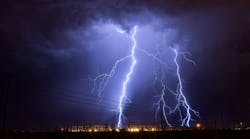California has unleashed a hornet's nest of activity. Many organizations are going back to the drawing board in an attempt to determine their roles in an ill-defined, state-managed electric industry. The California Power Exchange (PX) seems to have lost its relevance while shakeups have occurred at the vitally important independent system operator (ISO). I posed a series of questions to Pat Briody to capture his views on California, the ISOs and the industry as a whole.
T&D World: California is on every-one's mind. Is it fair to blame California's problems on deregulation?
Briody: Deregulation, no. Flawed deregulation, yes — among many other factors, including an uncertain regulatory climate over the last decade, making generation investments highly risky; a not-on-my-planet mentality; and a booming economy driving dramatic load growth. The political machinations and rush to judgment in deregulating California were responsible for a market model inconsistent with the physical model. That's not the case in 23 other states that have deregulated. Pennsylvania deregulation has saved its customers US$3 billion already. While its 900 generators and 12,500 miles (20,116 km) of transmission lines make California a very large player, it is hardly the universe.
T&D World: Do you think it was necessary to rip generation out of the hands of the big investor-owned utilities (IOUs)?
Briody: Only because they were so big. If Pacific Gas & Electric (PG&E) and Southern California Edison (SCE) retained all their generation assets, they would have too much market power. In a successfully deregulated market, competition flourishes. That competition is among generators — both independent power producers and verticals — but you need many of them with the proper incentives to make it work.
T&D World: Why have an ISO? It doesn't seem to have the muscle to get critical lines built.
Briody: Additional generation, transmission or a combination can solve supply problems. ISOs are neutral to the solution. ISOs perform reliability assessments, develop transmission expansion plans and can mandate transmission construction when required.
T&D World: Does the for-profit transmission company (transco) model make more sense?
Briody: While ISOs are solution neutral, a transco, owning transmission assets, would tend to favor a transmission solution rather than a generation one. Incidentally, not all ISOs are nonprofit.
T&D World: Is the pool concept dead? Didn't we learn from England that pools send the wrong pricing signals?
Briody: Some five years ago I had lunch with Greg Conlon, who was then chairman of the California Public Utility Commission (PUC). He had just returned from several weeks in the United Kingdom where he studied its model. I guess he took the wrong course. Pools don't make a lot of sense if the industry is to be market driven.
T&D World: Are bilateral contracts the future?
Briody: Yes, and the past and present as well — but not exclusively. Bilaterals have been around since Three-Mile Island, but today they are complemented by the spot market and self-scheduled generation. To have a market requires price transparency. Bilaterals don't give you that.
T&D World: How many ISO members do you have?
Briody: The ISO CIO Council has seven: the California ISO, the New York ISO, ISO-New England, the Electricity Reliability Council of Texas (ERCOT), the Midwest ISO, Ontario's Independent Electricity Market Operator (IMO) and the Pennsylvania-New Jersey-Maryland (PJM) power pool.
T&D World: What kind of chaos exists in the ISO world right now?
Briody: Well, California and the Midwest ISO are all over the floor. The others are just going about their business. There have been quite a few defections from ISO executive ranks. The joke is that if your name ends in “O” and you are a CEO of an ISO, then you're gone-zo! California ISO just lost a fine CIO, Dennis Fishback, to a generator. Then, I read the half-life of the average CIO is only 17 months these days. Think about how many five-year plans ever get implemented. The mixed motivations of the governance structures of many ISOs provide mixed signals to the executive tier.
T&D World: What is happening over at the California Power Exchange? Is it making any money?
Briody: The California Power Exchange had intended to migrate toward trading in other markets, but the latest events in California aborted its plan and led to its demise. It is scheduled to go out of business in a few months. There's a lot of finger pointing — mainly at the Federal Energy Regulatory Commission (FERC), but I don't think profitability was ever a major issue.
T&D World: Do we have a supply problem in California or do we have a transport problem?
Briody: My understanding is that it is mostly supply.
T&D World: Matt Cordaro, former CEO of Midwest ISO, told T&D World editors last May that it might take a major blackout to get us building lines again in critical areas of the country. His words certainly seem prophetic.
Briody: Certainly, major blackouts get people moving. But, as I said, I think a generation shortfall, rather than transport, is responsible for California's woes. And before we get too alarmed, we need to recognize there's a big difference between a controlled vs. an uncontrolled blackout. The uncertainty that preceded deregulation and diminished interest in new generation and transmission has had the effect of tightening margins in many areas, as Cordaro indicates. The industry in general is in catch-up mode.
T&D World: Do you see any push for a national grid?
Briody: I think FERC has stated its vision is of three major organizations managing the grid. Right now we have the Eastern, Western and Texas interconnections. I think the trend is toward larger, rather than smaller, scheduling authorities, but I don't see them growing beyond the boundaries of these three. These larger organizations would support more diversity in fuel supplies, generating unit types, weather patterns and customer usage.
T&D World: How about separating grids with direct current (dc)?
Briody: Among the three interconnections, dc ties enable the separation today. The dc ties serve to isolate the three from a reliability standpoint.
T&D World: State PUCs are putting the brakes on deregulation. How will this affect the formation of ISOs and transcos?
Briody: In general, the Western states will slow down because California's problems have become theirs. On the other hand, I don't think there will be much impact among thoughtful PUCs in the rest of the country.
T&D World: What can utilities in other countries learn from California?
Briody: Little steps for little people. California's model was not phased in, it was conceived and implemented in haste, foisting a buy-high, sell-low business model on PG&E and SCE. Deregulation in other countries often is associated with privatization, which slows the process down anyway. South American utilities are following a thoughtfully slow course in Brazil, Argentina and Chile, and are looking more to a PJM model than to California's. Japan, which does not need to go through a privatization phase, had considered California a model, but now will look elsewhere.
T&D World: Is there a silver bullet for California?
Briody: There aren't enough bullets to go around. Seriously, a college recently suggested that generation could be priced on a cost-plus basis (say 15% maximum) with the percentage varying by individual generator. This strategy would cap prices and profitability. Underneath the cap, an open market would run — a generator could bid in less than the 15% if it chose. Gradually, as the market developed, the percentage could be increased until ultimately it would be dropped. That sounds like an interesting approach to me.
T&D World: So where is all this headed?
Briody: People are resourceful. Down the road, I envision distributed generation obviating the need for much of today's transmission and distribution network (and consequently the jobs of many of your readers). Electric transmission will be phased out in favor of fuel transport. Siting and many other environmental issues will become moot. Forget blackouts getting us back to building transmission. They might well stimulate a rugged individualism and a massive move to individual ownership of electric generation. But that's another story, isn't it?
L. Patrick Briody is an independent consultant focused on the utilities industry. He retired from IBM in 1989 after 27 years of service. He was first associated with IBM's interests in the utilities industry in 1969, when he worked as that sector's planning manager until 1972. From 1981 to 1989, Briody was responsible for all U.S. utilities and was IBM's primary spokesman for and to the industry. Since leaving IBM and forming Briody Associates, his consulting engagements have included a wide range of utility-related matters, including assignments for utilities, their suppliers, Independent System Operators (ISOs), Power Exchanges (PXs), market research firms and the trade press.
Recently, Briody was named executive director of the ISO/PX CIO Council. Founded in 2000, the group of CIOs strives to enhance the efficiency and effectiveness of its information systems through cooperative efforts in areas such as standards, shared development and procurement.

